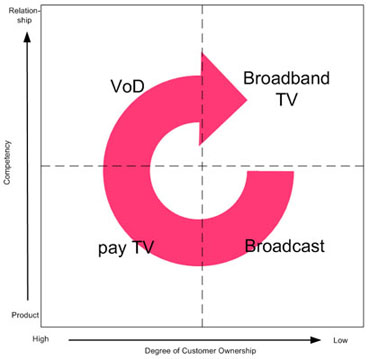This is the title of my most recent study project, over which I just graduated to MBA in Media Management. Below I want to give a little impression of what the paper was about.
The paradigmatic changes of consumers’ value prop – all of which are regular subject to this blog and thus shall not be repeated here – affect a number of related industries and throw up a plethora of questions on the future distribution of filmed entertainment.
“We are searching for the new platform or the new channel that will drive the profits in the future, but there are so many unknowns . . . What we do know is that the entire model is up for grabs.”,
said Kevin Tsujihara, president of Warner Bros. Home Entertainment Group already in 2005, marking a change in executives’ mindsets that is almost common sense among industry leaders today.
The thesis focuses on processes, operations and questions of a strategic innovation management resulting from the tectonic shift filmed entertainment is undergoing these days. Extracts of data from all important segments are being collected, agnostic of platform or delivery method, since market segmentation in IP’s advent to TV needs to embrace a new scope of competition. Underlying core belief is that markets are substantially driven by customers’ sets of needs and attached value propositions and hence products can only be developed by careful exploration of those needs. Ratio of argumentation is that by building up excellence in meeting those needs, traces for exploiting customer base and benefit from such engagement can be found.
Core interest of the paper was to discover differentiation options by leveraging open network services and their multicast and participation capabilities in comparison to linear broadcast service offerings of the past. What drives users of mass market numbers now to the Internet and its myriads of communities and social networks?
What can managed network operators and content providers learn from this migration? How can they incorporate success factors into their own environments and drive market evolvement actively?
In order to reach to those findings, the opening chapter of the paper is concerned with a basic description of the platforms competition, their respective service propositions and fundamentals about the essence of value add.
Basic usage patterns and distinct user types in the fragmenting media landscape where examined in the next chapter. Seven key trends in digital individualization helped in the later course of the research at determining success factors and framing disruption to industry incumbents. Following up background information on changing motives and value capture within networked media was provided.
Chapter 3, Service Analysis, added more insights to the industry. It investigated more of the specific structure of each market and general industry independencies by analyzing value chains and business webs, generic payment models and exemplified offerings of digital TV (“Best of Breed”), IPTV (“The Pioneers”) and Broadband TV (“The Trials”). Basic assumptions for pre-requisites to success at on-demand content provision where drawn and lead to three key success factors. Content range, value add by functionality and achieving convenient media experiences. Broadband TV brings strong complementary capabilities to the area of broadcast, so in a summary to the service analysis chapter the evolutionary effects of broadband video to the industry where illustrated.
In Chapter 4 resource-based perspective was added to the examination. Variables for a successful differentiation where collected in here.
But what path towards achieving innovation advantage can be chosen? The essence of paradigmatic changes examined was subsumed in the last part and the findings are attached to three types of new aggregation services (Microplatforms, Aggregators and Reconstructors, following Umair’s classification).
Network effects occurring out of distributed economies of scale waited to be explored. Absorbing of users’ value propositions and inviting them to participatory engagement turns out to be a likely way to go. Analyzing incorporation potential requires to look distinctly to
barriers of technical, economical or other structural and cultural origin. Although broadcast and pay TV still yields by far the largest share of exploitation of TV contents, signs are for change. TV companies should use their strengths in building up relationships because of their high competence in creating emotion and involvement. In the course of the thesis its being demonstrated that they are lacking capabilities to develop thoroughly and sustainable better relationships to their audience. It is being recommended for them to increasingly acquire resources that are not only asset driven, but aim to support engagement in the relationship business element of networked media of the future. By improving customer relationship, the degree of control enforcement will loose its exclusive importance.
Arguable approaches are shown in the following depict.

Business Model Paradigm in Networked TV Entertainment,
source: eyetag media engineers
This assessment frames two central dimensions of change being discovered in the thesis. Competency in relationship engagement with audiences on the y-axis and channel control or degree of customer ownership on x-axis. Those two dimensions shape basic occurrences of business approaches and draw the line between the traditional media model and the new, networked media environment. The arrow describes the evolvement of the business models and indicates market lifecycles from maturity (broadcast) to introduction (broadband TV).
In the paper it is suggested for media companies to incorporate “three pillars of the paradigm shift” (Business logics, Service Types and Business models) to their strategic agendas and thus to their innovation processes.
For mastering the manifold challenges of a networked, heavily Micromedia influenced and thus hyper competitive TV landscape, they will clearly need to perform better on the variables that determine industry disruption.
More information on the topic and the paper – as always – on request.


